Developing and Integrating a Workplace Wellness Program Report
VerifiedAdded on 2023/01/19
|12
|2153
|86
Report
AI Summary
This report provides a comprehensive analysis of workplace wellness programs, focusing on the development and integration of such programs within an organization. It begins by outlining the relevant legislative acts in occupational health and safety across different jurisdictions, emphasizing the rights and responsibilities of employers, supervisors, and workers. The report then delves into methods for assessing workplace hazards, including what-if analysis, checklists, control banding, and job hazard analysis. A significant portion of the report is dedicated to creating a plan to engage the workforce in health and safety issues, highlighting the importance of employee participation, motivation, and regular safety updates. Finally, the report examines the crucial roles of leadership teams and human resources in fostering a safe work environment, emphasizing communication, situational monitoring, and the implementation of safety policies. The report concludes with a summary of key findings and recommendations, emphasizing the importance of a robust occupational health and safety policy, training, and worker motivation for the success of any wellness program.
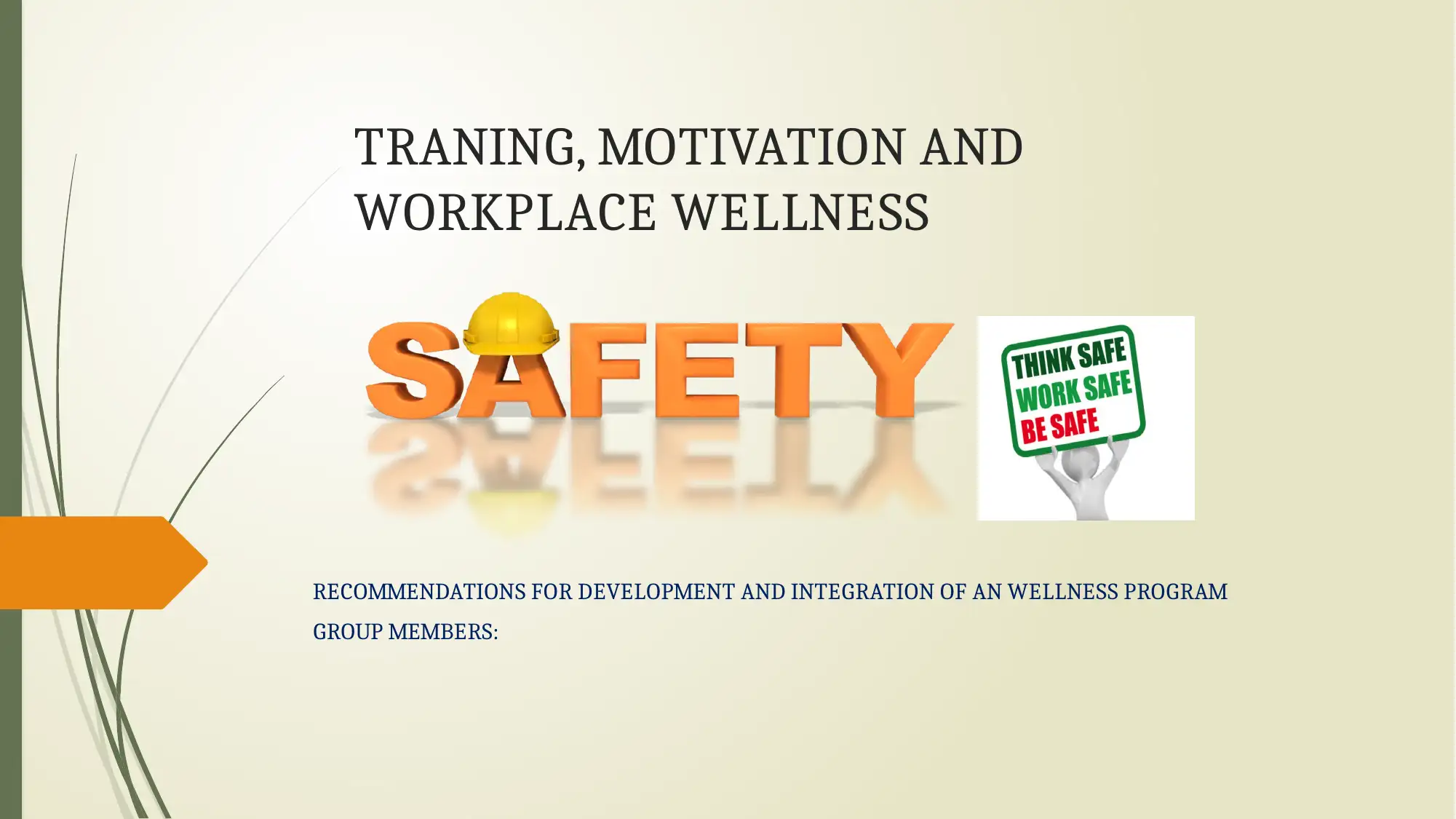
TRANING, MOTIVATION AND
WORKPLACE WELLNESS
RECOMMENDATIONS FOR DEVELOPMENT AND INTEGRATION OF AN WELLNESS PROGRAM
GROUP MEMBERS:
WORKPLACE WELLNESS
RECOMMENDATIONS FOR DEVELOPMENT AND INTEGRATION OF AN WELLNESS PROGRAM
GROUP MEMBERS:
Paraphrase This Document
Need a fresh take? Get an instant paraphrase of this document with our AI Paraphraser

LEARNING OUTCOMES TO BE COVERED
Explanation of the different legislative acts that apply to the occupational health
and safety of the workforce.
Recommendations of different methods of assessing the hazards within the
workplace.
Creation of a plan to engage the workforce in health and safety issues within the
workplace.
Explanation of the roles that leadership teams and human resources plays in
creating a safe work environment.
Explanation of the different legislative acts that apply to the occupational health
and safety of the workforce.
Recommendations of different methods of assessing the hazards within the
workplace.
Creation of a plan to engage the workforce in health and safety issues within the
workplace.
Explanation of the roles that leadership teams and human resources plays in
creating a safe work environment.
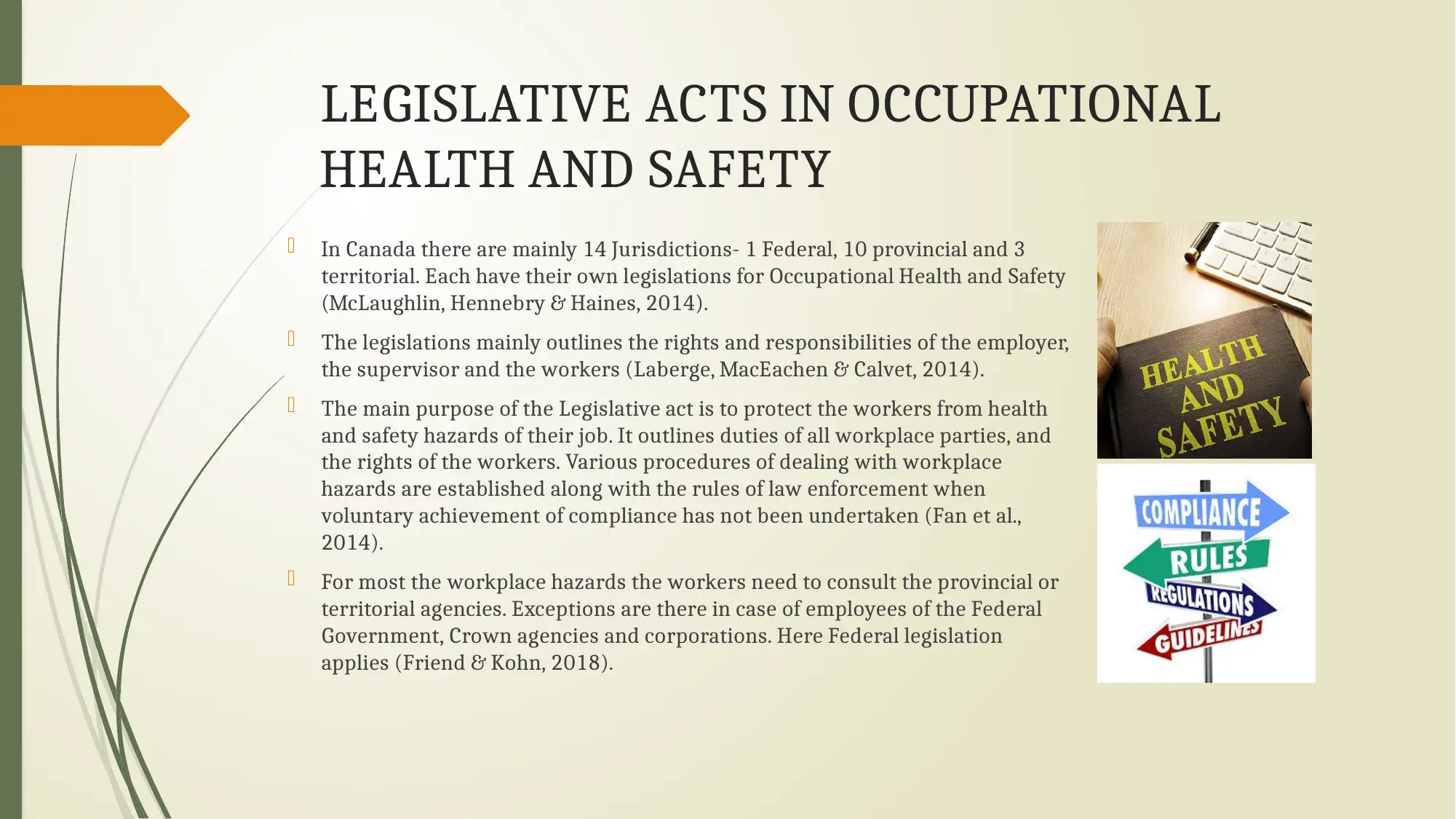
LEGISLATIVE ACTS IN OCCUPATIONAL
HEALTH AND SAFETY
In Canada there are mainly 14 Jurisdictions- 1 Federal, 10 provincial and 3
territorial. Each have their own legislations for Occupational Health and Safety
(McLaughlin, Hennebry & Haines, 2014).
The legislations mainly outlines the rights and responsibilities of the employer,
the supervisor and the workers (Laberge, MacEachen & Calvet, 2014).
The main purpose of the Legislative act is to protect the workers from health
and safety hazards of their job. It outlines duties of all workplace parties, and
the rights of the workers. Various procedures of dealing with workplace
hazards are established along with the rules of law enforcement when
voluntary achievement of compliance has not been undertaken (Fan et al.,
2014).
For most the workplace hazards the workers need to consult the provincial or
territorial agencies. Exceptions are there in case of employees of the Federal
Government, Crown agencies and corporations. Here Federal legislation
applies (Friend & Kohn, 2018).
HEALTH AND SAFETY
In Canada there are mainly 14 Jurisdictions- 1 Federal, 10 provincial and 3
territorial. Each have their own legislations for Occupational Health and Safety
(McLaughlin, Hennebry & Haines, 2014).
The legislations mainly outlines the rights and responsibilities of the employer,
the supervisor and the workers (Laberge, MacEachen & Calvet, 2014).
The main purpose of the Legislative act is to protect the workers from health
and safety hazards of their job. It outlines duties of all workplace parties, and
the rights of the workers. Various procedures of dealing with workplace
hazards are established along with the rules of law enforcement when
voluntary achievement of compliance has not been undertaken (Fan et al.,
2014).
For most the workplace hazards the workers need to consult the provincial or
territorial agencies. Exceptions are there in case of employees of the Federal
Government, Crown agencies and corporations. Here Federal legislation
applies (Friend & Kohn, 2018).
⊘ This is a preview!⊘
Do you want full access?
Subscribe today to unlock all pages.

Trusted by 1+ million students worldwide
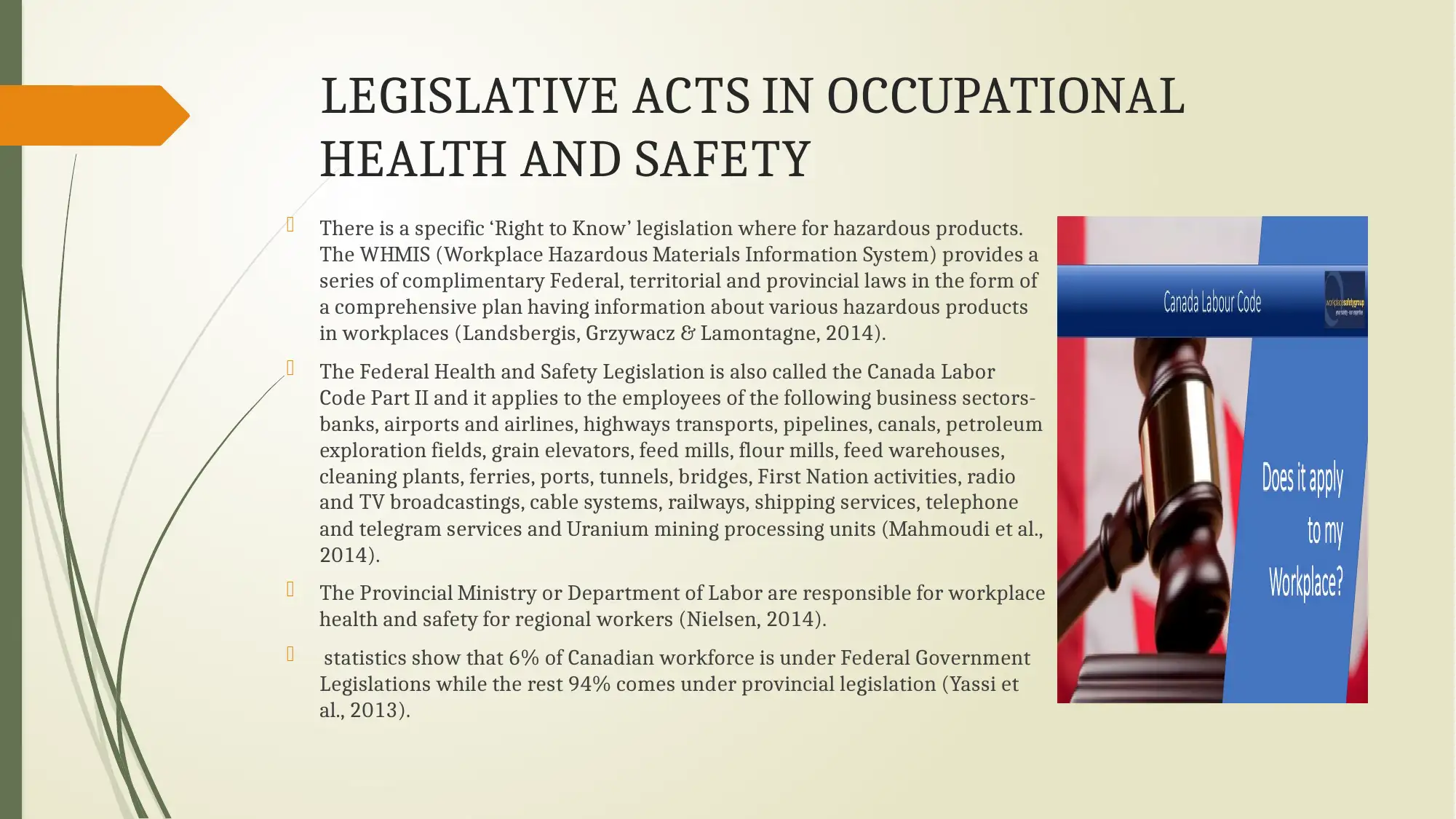
LEGISLATIVE ACTS IN OCCUPATIONAL
HEALTH AND SAFETY
There is a specific ‘Right to Know’ legislation where for hazardous products.
The WHMIS (Workplace Hazardous Materials Information System) provides a
series of complimentary Federal, territorial and provincial laws in the form of
a comprehensive plan having information about various hazardous products
in workplaces (Landsbergis, Grzywacz & Lamontagne, 2014).
The Federal Health and Safety Legislation is also called the Canada Labor
Code Part II and it applies to the employees of the following business sectors-
banks, airports and airlines, highways transports, pipelines, canals, petroleum
exploration fields, grain elevators, feed mills, flour mills, feed warehouses,
cleaning plants, ferries, ports, tunnels, bridges, First Nation activities, radio
and TV broadcastings, cable systems, railways, shipping services, telephone
and telegram services and Uranium mining processing units (Mahmoudi et al.,
2014).
The Provincial Ministry or Department of Labor are responsible for workplace
health and safety for regional workers (Nielsen, 2014).
statistics show that 6% of Canadian workforce is under Federal Government
Legislations while the rest 94% comes under provincial legislation (Yassi et
al., 2013).
HEALTH AND SAFETY
There is a specific ‘Right to Know’ legislation where for hazardous products.
The WHMIS (Workplace Hazardous Materials Information System) provides a
series of complimentary Federal, territorial and provincial laws in the form of
a comprehensive plan having information about various hazardous products
in workplaces (Landsbergis, Grzywacz & Lamontagne, 2014).
The Federal Health and Safety Legislation is also called the Canada Labor
Code Part II and it applies to the employees of the following business sectors-
banks, airports and airlines, highways transports, pipelines, canals, petroleum
exploration fields, grain elevators, feed mills, flour mills, feed warehouses,
cleaning plants, ferries, ports, tunnels, bridges, First Nation activities, radio
and TV broadcastings, cable systems, railways, shipping services, telephone
and telegram services and Uranium mining processing units (Mahmoudi et al.,
2014).
The Provincial Ministry or Department of Labor are responsible for workplace
health and safety for regional workers (Nielsen, 2014).
statistics show that 6% of Canadian workforce is under Federal Government
Legislations while the rest 94% comes under provincial legislation (Yassi et
al., 2013).
Paraphrase This Document
Need a fresh take? Get an instant paraphrase of this document with our AI Paraphraser
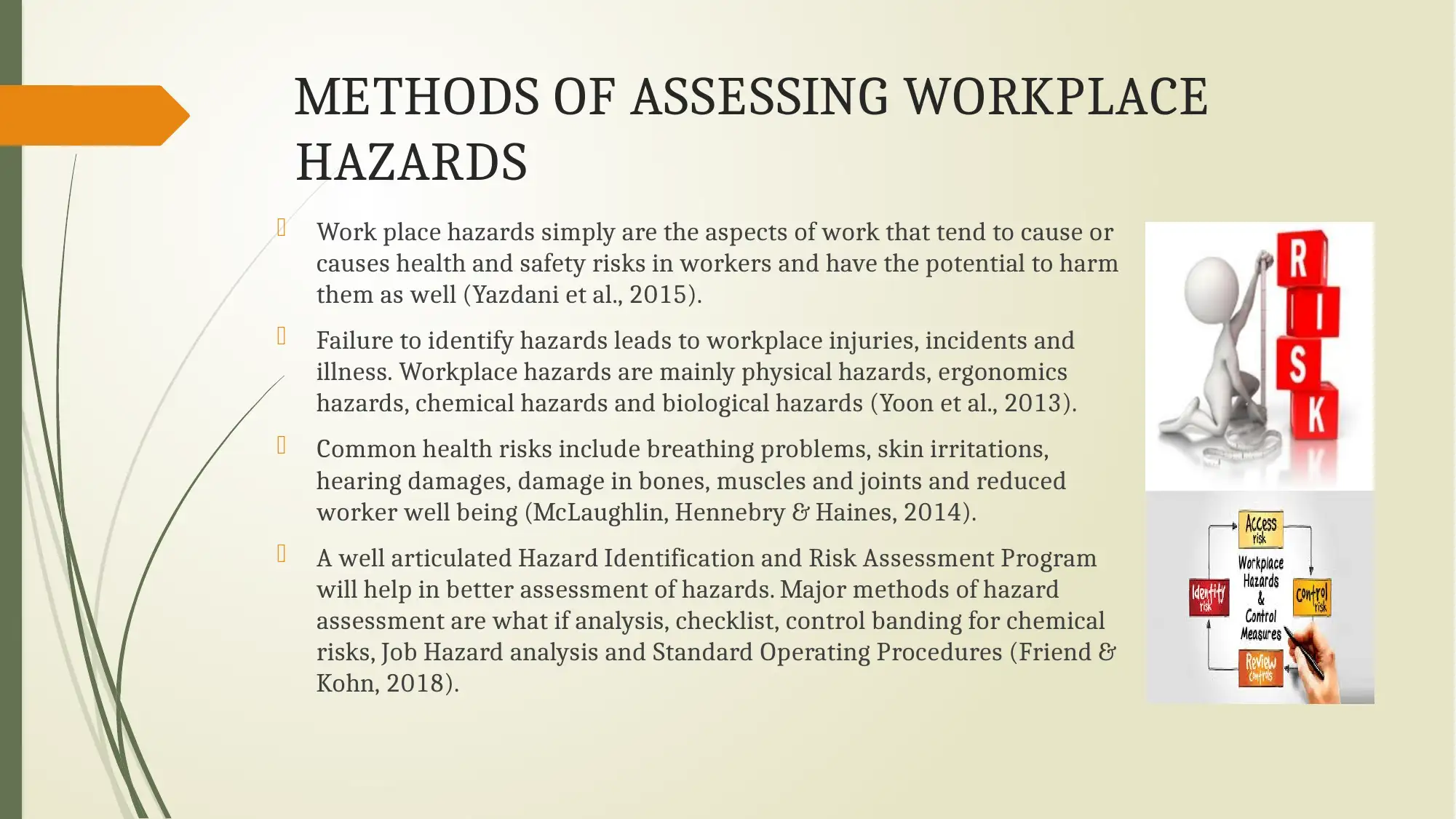
METHODS OF ASSESSING WORKPLACE
HAZARDS
Work place hazards simply are the aspects of work that tend to cause or
causes health and safety risks in workers and have the potential to harm
them as well (Yazdani et al., 2015).
Failure to identify hazards leads to workplace injuries, incidents and
illness. Workplace hazards are mainly physical hazards, ergonomics
hazards, chemical hazards and biological hazards (Yoon et al., 2013).
Common health risks include breathing problems, skin irritations,
hearing damages, damage in bones, muscles and joints and reduced
worker well being (McLaughlin, Hennebry & Haines, 2014).
A well articulated Hazard Identification and Risk Assessment Program
will help in better assessment of hazards. Major methods of hazard
assessment are what if analysis, checklist, control banding for chemical
risks, Job Hazard analysis and Standard Operating Procedures (Friend &
Kohn, 2018).
HAZARDS
Work place hazards simply are the aspects of work that tend to cause or
causes health and safety risks in workers and have the potential to harm
them as well (Yazdani et al., 2015).
Failure to identify hazards leads to workplace injuries, incidents and
illness. Workplace hazards are mainly physical hazards, ergonomics
hazards, chemical hazards and biological hazards (Yoon et al., 2013).
Common health risks include breathing problems, skin irritations,
hearing damages, damage in bones, muscles and joints and reduced
worker well being (McLaughlin, Hennebry & Haines, 2014).
A well articulated Hazard Identification and Risk Assessment Program
will help in better assessment of hazards. Major methods of hazard
assessment are what if analysis, checklist, control banding for chemical
risks, Job Hazard analysis and Standard Operating Procedures (Friend &
Kohn, 2018).
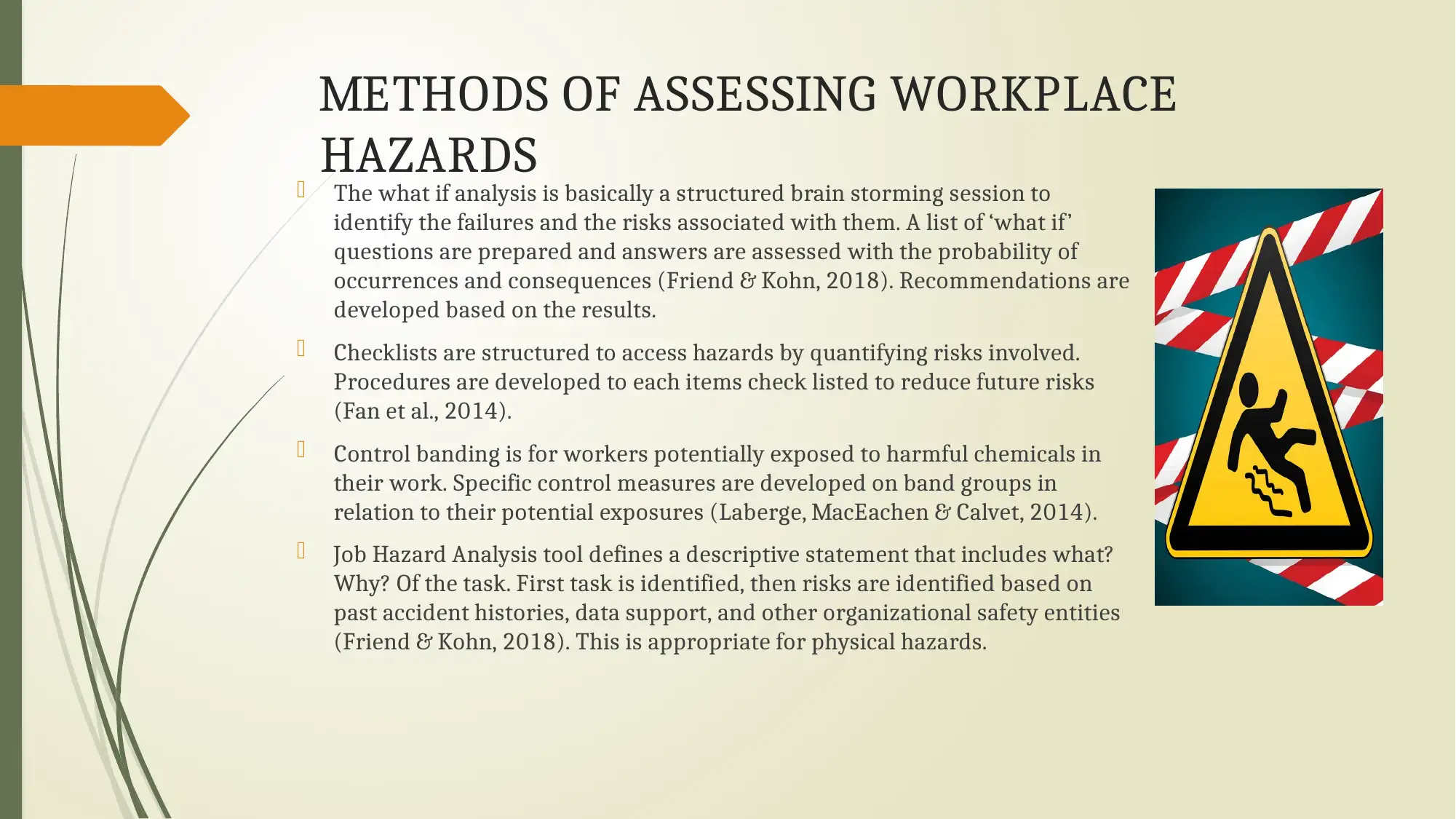
METHODS OF ASSESSING WORKPLACE
HAZARDS The what if analysis is basically a structured brain storming session to
identify the failures and the risks associated with them. A list of ‘what if’
questions are prepared and answers are assessed with the probability of
occurrences and consequences (Friend & Kohn, 2018). Recommendations are
developed based on the results.
Checklists are structured to access hazards by quantifying risks involved.
Procedures are developed to each items check listed to reduce future risks
(Fan et al., 2014).
Control banding is for workers potentially exposed to harmful chemicals in
their work. Specific control measures are developed on band groups in
relation to their potential exposures (Laberge, MacEachen & Calvet, 2014).
Job Hazard Analysis tool defines a descriptive statement that includes what?
Why? Of the task. First task is identified, then risks are identified based on
past accident histories, data support, and other organizational safety entities
(Friend & Kohn, 2018). This is appropriate for physical hazards.
HAZARDS The what if analysis is basically a structured brain storming session to
identify the failures and the risks associated with them. A list of ‘what if’
questions are prepared and answers are assessed with the probability of
occurrences and consequences (Friend & Kohn, 2018). Recommendations are
developed based on the results.
Checklists are structured to access hazards by quantifying risks involved.
Procedures are developed to each items check listed to reduce future risks
(Fan et al., 2014).
Control banding is for workers potentially exposed to harmful chemicals in
their work. Specific control measures are developed on band groups in
relation to their potential exposures (Laberge, MacEachen & Calvet, 2014).
Job Hazard Analysis tool defines a descriptive statement that includes what?
Why? Of the task. First task is identified, then risks are identified based on
past accident histories, data support, and other organizational safety entities
(Friend & Kohn, 2018). This is appropriate for physical hazards.
⊘ This is a preview!⊘
Do you want full access?
Subscribe today to unlock all pages.

Trusted by 1+ million students worldwide

PLAN TO ENGAGE THE WORKFORCE IN HEALTH
AND SAFETY ISSUES WITHIN THE WORKPLACE
Occupational Health and Safety is the biggest nightmare for every organization. that
is why safety survey is must for every organization (Friend & Kohn, 2018).
Organizations understand the fact that employee engagement leads to workplace
safety very well. For this they focus more on action planning prioritizing workplace
health and safety. The plan should include integration, learning and development,
engagement and ownership, recognition, meet-ups and results and finally
protecting employees voices (Landsbergis, Grzywacz & Lamontagne, 2014).
Worker participation involves workers in establishing, operating, evaluating, and
improving the health and safety programs. A wellness program will add more
effectiveness to the plan (Mahmoudi et al., 2014). The sample plan of the program
need to focus on,
Encouraging workers to participate in the program.
Encouraging workers to report health and safety programs on a timely basis.
Providing the workers the access to health and safety information.
Involving the workers actively in all aspects of the program.
Removing participation barriers if any.
AND SAFETY ISSUES WITHIN THE WORKPLACE
Occupational Health and Safety is the biggest nightmare for every organization. that
is why safety survey is must for every organization (Friend & Kohn, 2018).
Organizations understand the fact that employee engagement leads to workplace
safety very well. For this they focus more on action planning prioritizing workplace
health and safety. The plan should include integration, learning and development,
engagement and ownership, recognition, meet-ups and results and finally
protecting employees voices (Landsbergis, Grzywacz & Lamontagne, 2014).
Worker participation involves workers in establishing, operating, evaluating, and
improving the health and safety programs. A wellness program will add more
effectiveness to the plan (Mahmoudi et al., 2014). The sample plan of the program
need to focus on,
Encouraging workers to participate in the program.
Encouraging workers to report health and safety programs on a timely basis.
Providing the workers the access to health and safety information.
Involving the workers actively in all aspects of the program.
Removing participation barriers if any.
Paraphrase This Document
Need a fresh take? Get an instant paraphrase of this document with our AI Paraphraser

PLAN TO ENGAGE THE WORKFORCE IN HEALTH
AND SAFETY ISSUES WITHIN THE WORKPLACE
In order to increase workforce engagement in health and safety issues the
workforce need to be motivated which can be done in the following manners,
Making health and safety and important part of the organizational culture.
Leadership teams should support safety widely and should encourage their
subordinates the same.
Use of positive reinforcement should be increased.
Employees should be empowered and should feel the need for self-safety.
Feedback of employees should be collected to review the safety programs.
In addition to all these regular safety updates need to be provided to the
workers and training on equipment handling, risks analysis and workplace
policies of health and safety need to be provided as well (Mahmoudi et al.,
2014).
AND SAFETY ISSUES WITHIN THE WORKPLACE
In order to increase workforce engagement in health and safety issues the
workforce need to be motivated which can be done in the following manners,
Making health and safety and important part of the organizational culture.
Leadership teams should support safety widely and should encourage their
subordinates the same.
Use of positive reinforcement should be increased.
Employees should be empowered and should feel the need for self-safety.
Feedback of employees should be collected to review the safety programs.
In addition to all these regular safety updates need to be provided to the
workers and training on equipment handling, risks analysis and workplace
policies of health and safety need to be provided as well (Mahmoudi et al.,
2014).
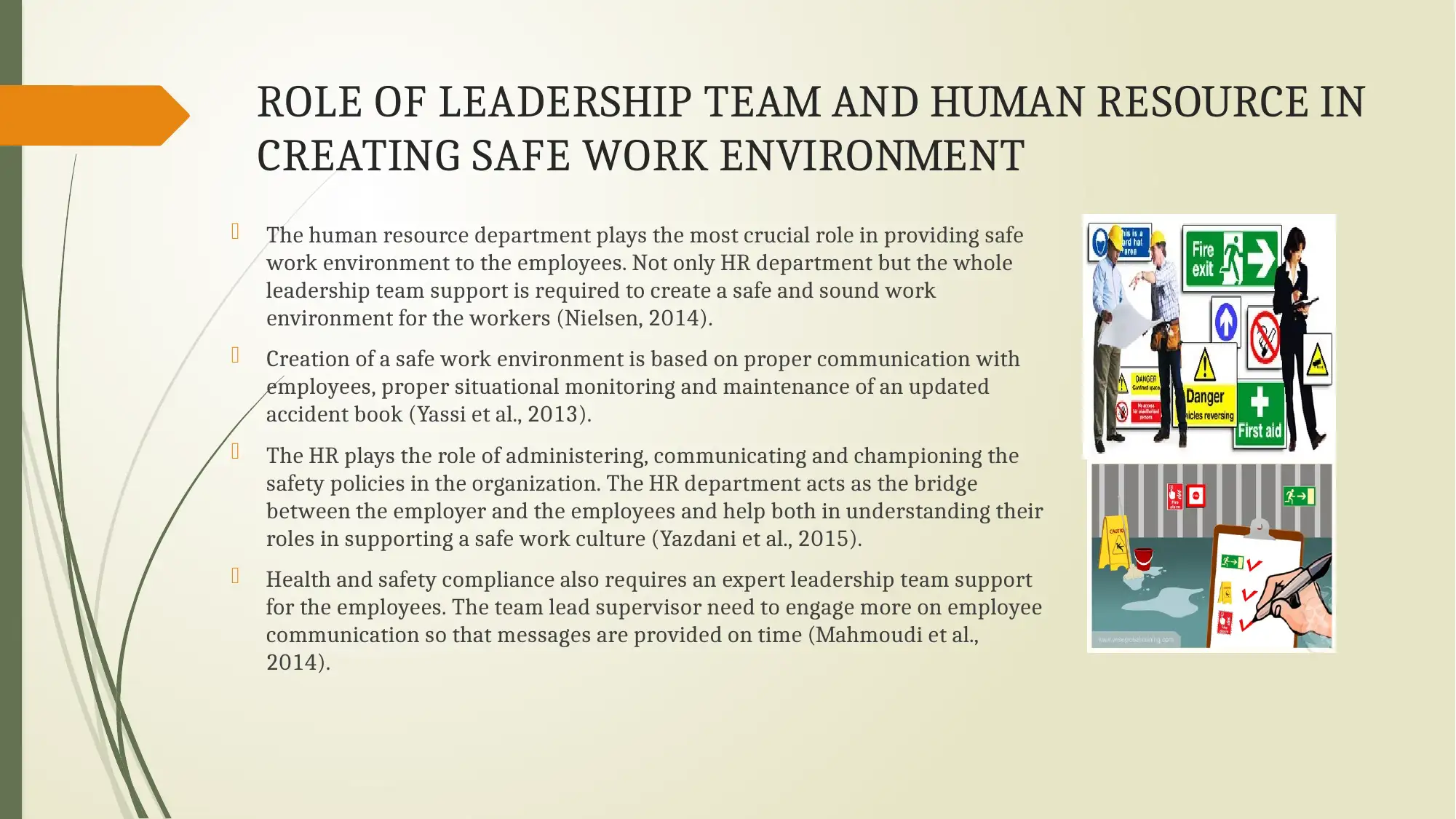
ROLE OF LEADERSHIP TEAM AND HUMAN RESOURCE IN
CREATING SAFE WORK ENVIRONMENT
The human resource department plays the most crucial role in providing safe
work environment to the employees. Not only HR department but the whole
leadership team support is required to create a safe and sound work
environment for the workers (Nielsen, 2014).
Creation of a safe work environment is based on proper communication with
employees, proper situational monitoring and maintenance of an updated
accident book (Yassi et al., 2013).
The HR plays the role of administering, communicating and championing the
safety policies in the organization. The HR department acts as the bridge
between the employer and the employees and help both in understanding their
roles in supporting a safe work culture (Yazdani et al., 2015).
Health and safety compliance also requires an expert leadership team support
for the employees. The team lead supervisor need to engage more on employee
communication so that messages are provided on time (Mahmoudi et al.,
2014).
CREATING SAFE WORK ENVIRONMENT
The human resource department plays the most crucial role in providing safe
work environment to the employees. Not only HR department but the whole
leadership team support is required to create a safe and sound work
environment for the workers (Nielsen, 2014).
Creation of a safe work environment is based on proper communication with
employees, proper situational monitoring and maintenance of an updated
accident book (Yassi et al., 2013).
The HR plays the role of administering, communicating and championing the
safety policies in the organization. The HR department acts as the bridge
between the employer and the employees and help both in understanding their
roles in supporting a safe work culture (Yazdani et al., 2015).
Health and safety compliance also requires an expert leadership team support
for the employees. The team lead supervisor need to engage more on employee
communication so that messages are provided on time (Mahmoudi et al.,
2014).
⊘ This is a preview!⊘
Do you want full access?
Subscribe today to unlock all pages.

Trusted by 1+ million students worldwide
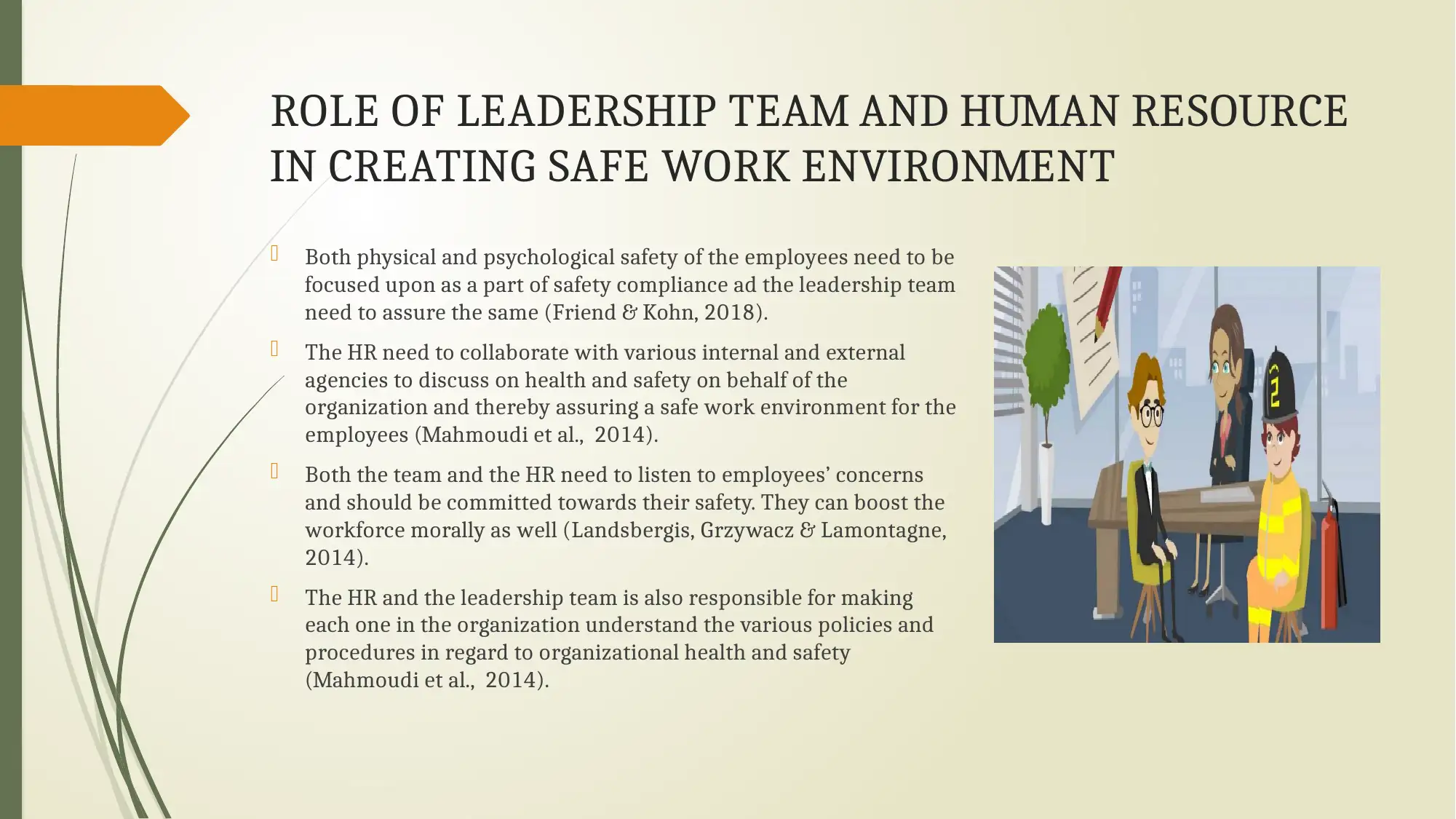
ROLE OF LEADERSHIP TEAM AND HUMAN RESOURCE
IN CREATING SAFE WORK ENVIRONMENT
Both physical and psychological safety of the employees need to be
focused upon as a part of safety compliance ad the leadership team
need to assure the same (Friend & Kohn, 2018).
The HR need to collaborate with various internal and external
agencies to discuss on health and safety on behalf of the
organization and thereby assuring a safe work environment for the
employees (Mahmoudi et al., 2014).
Both the team and the HR need to listen to employees’ concerns
and should be committed towards their safety. They can boost the
workforce morally as well (Landsbergis, Grzywacz & Lamontagne,
2014).
The HR and the leadership team is also responsible for making
each one in the organization understand the various policies and
procedures in regard to organizational health and safety
(Mahmoudi et al., 2014).
IN CREATING SAFE WORK ENVIRONMENT
Both physical and psychological safety of the employees need to be
focused upon as a part of safety compliance ad the leadership team
need to assure the same (Friend & Kohn, 2018).
The HR need to collaborate with various internal and external
agencies to discuss on health and safety on behalf of the
organization and thereby assuring a safe work environment for the
employees (Mahmoudi et al., 2014).
Both the team and the HR need to listen to employees’ concerns
and should be committed towards their safety. They can boost the
workforce morally as well (Landsbergis, Grzywacz & Lamontagne,
2014).
The HR and the leadership team is also responsible for making
each one in the organization understand the various policies and
procedures in regard to organizational health and safety
(Mahmoudi et al., 2014).
Paraphrase This Document
Need a fresh take? Get an instant paraphrase of this document with our AI Paraphraser
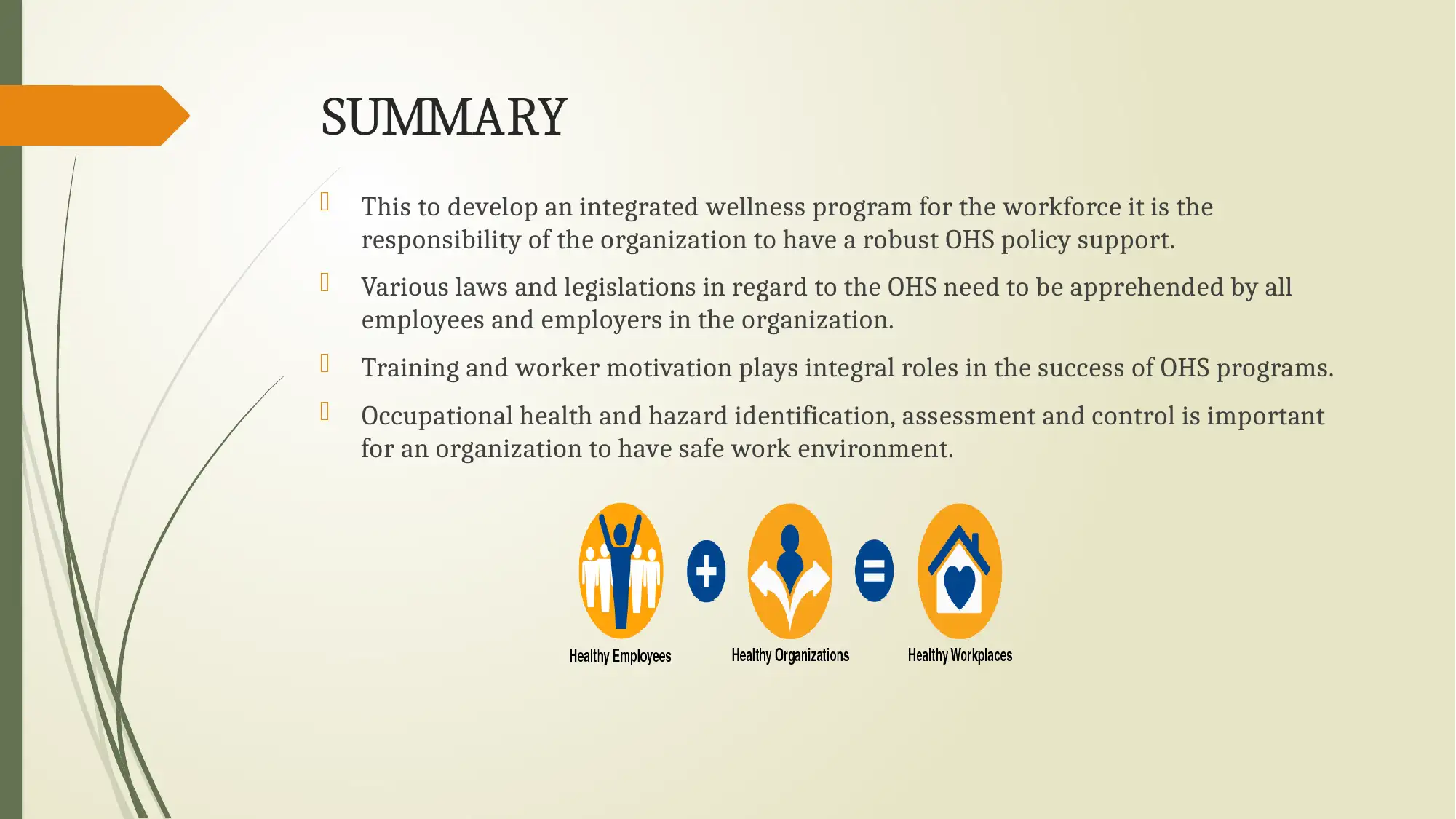
SUMMARY
This to develop an integrated wellness program for the workforce it is the
responsibility of the organization to have a robust OHS policy support.
Various laws and legislations in regard to the OHS need to be apprehended by all
employees and employers in the organization.
Training and worker motivation plays integral roles in the success of OHS programs.
Occupational health and hazard identification, assessment and control is important
for an organization to have safe work environment.
This to develop an integrated wellness program for the workforce it is the
responsibility of the organization to have a robust OHS policy support.
Various laws and legislations in regard to the OHS need to be apprehended by all
employees and employers in the organization.
Training and worker motivation plays integral roles in the success of OHS programs.
Occupational health and hazard identification, assessment and control is important
for an organization to have safe work environment.
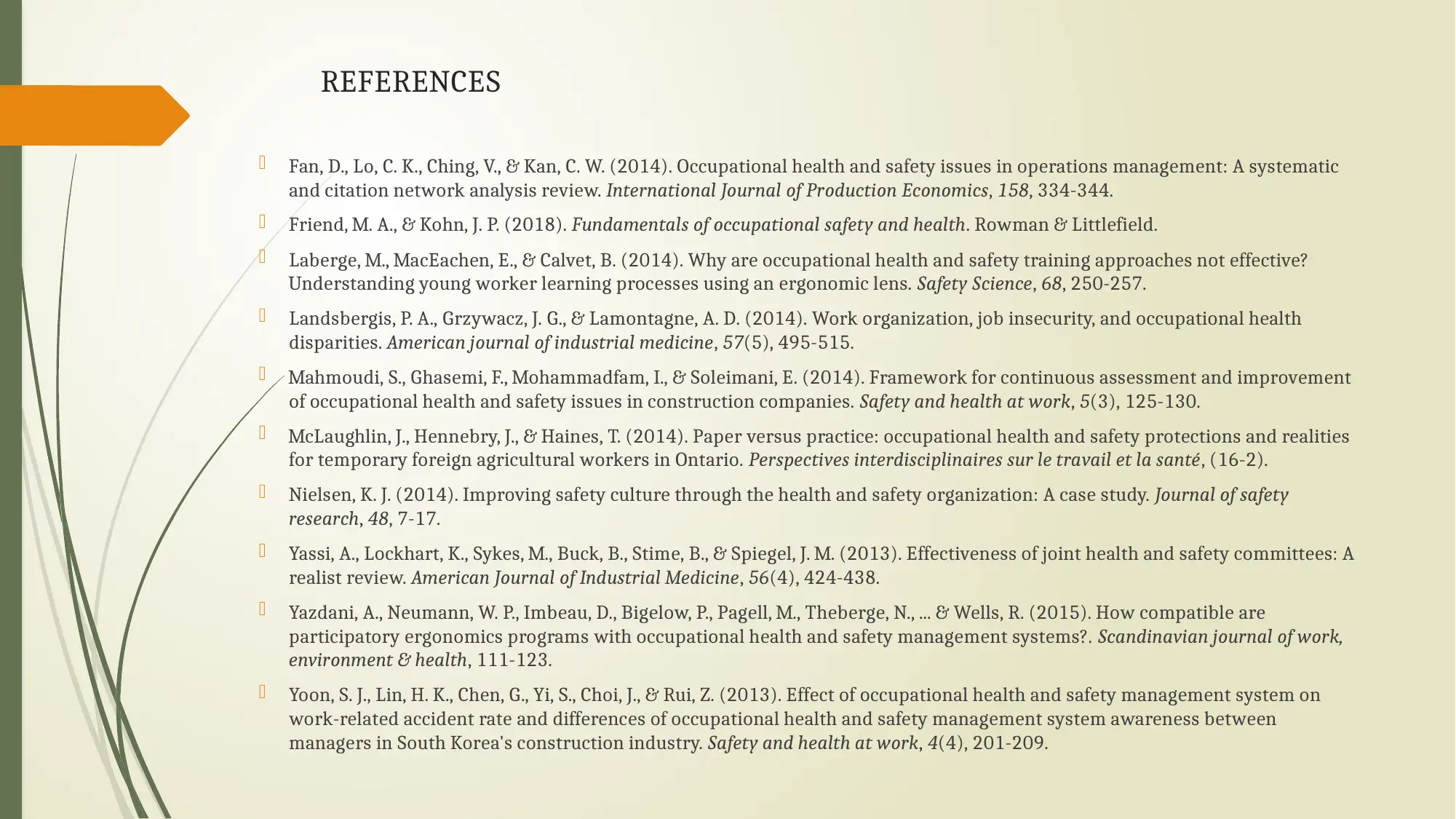
REFERENCES
Fan, D., Lo, C. K., Ching, V., & Kan, C. W. (2014). Occupational health and safety issues in operations management: A systematic
and citation network analysis review. International Journal of Production Economics, 158, 334-344.
Friend, M. A., & Kohn, J. P. (2018). Fundamentals of occupational safety and health. Rowman & Littlefield.
Laberge, M., MacEachen, E., & Calvet, B. (2014). Why are occupational health and safety training approaches not effective?
Understanding young worker learning processes using an ergonomic lens. Safety Science, 68, 250-257.
Landsbergis, P. A., Grzywacz, J. G., & Lamontagne, A. D. (2014). Work organization, job insecurity, and occupational health
disparities. American journal of industrial medicine, 57(5), 495-515.
Mahmoudi, S., Ghasemi, F., Mohammadfam, I., & Soleimani, E. (2014). Framework for continuous assessment and improvement
of occupational health and safety issues in construction companies. Safety and health at work, 5(3), 125-130.
McLaughlin, J., Hennebry, J., & Haines, T. (2014). Paper versus practice: occupational health and safety protections and realities
for temporary foreign agricultural workers in Ontario. Perspectives interdisciplinaires sur le travail et la santé, (16-2).
Nielsen, K. J. (2014). Improving safety culture through the health and safety organization: A case study. Journal of safety
research, 48, 7-17.
Yassi, A., Lockhart, K., Sykes, M., Buck, B., Stime, B., & Spiegel, J. M. (2013). Effectiveness of joint health and safety committees: A
realist review. American Journal of Industrial Medicine, 56(4), 424-438.
Yazdani, A., Neumann, W. P., Imbeau, D., Bigelow, P., Pagell, M., Theberge, N., ... & Wells, R. (2015). How compatible are
participatory ergonomics programs with occupational health and safety management systems?. Scandinavian journal of work,
environment & health, 111-123.
Yoon, S. J., Lin, H. K., Chen, G., Yi, S., Choi, J., & Rui, Z. (2013). Effect of occupational health and safety management system on
work-related accident rate and differences of occupational health and safety management system awareness between
managers in South Korea's construction industry. Safety and health at work, 4(4), 201-209.
Fan, D., Lo, C. K., Ching, V., & Kan, C. W. (2014). Occupational health and safety issues in operations management: A systematic
and citation network analysis review. International Journal of Production Economics, 158, 334-344.
Friend, M. A., & Kohn, J. P. (2018). Fundamentals of occupational safety and health. Rowman & Littlefield.
Laberge, M., MacEachen, E., & Calvet, B. (2014). Why are occupational health and safety training approaches not effective?
Understanding young worker learning processes using an ergonomic lens. Safety Science, 68, 250-257.
Landsbergis, P. A., Grzywacz, J. G., & Lamontagne, A. D. (2014). Work organization, job insecurity, and occupational health
disparities. American journal of industrial medicine, 57(5), 495-515.
Mahmoudi, S., Ghasemi, F., Mohammadfam, I., & Soleimani, E. (2014). Framework for continuous assessment and improvement
of occupational health and safety issues in construction companies. Safety and health at work, 5(3), 125-130.
McLaughlin, J., Hennebry, J., & Haines, T. (2014). Paper versus practice: occupational health and safety protections and realities
for temporary foreign agricultural workers in Ontario. Perspectives interdisciplinaires sur le travail et la santé, (16-2).
Nielsen, K. J. (2014). Improving safety culture through the health and safety organization: A case study. Journal of safety
research, 48, 7-17.
Yassi, A., Lockhart, K., Sykes, M., Buck, B., Stime, B., & Spiegel, J. M. (2013). Effectiveness of joint health and safety committees: A
realist review. American Journal of Industrial Medicine, 56(4), 424-438.
Yazdani, A., Neumann, W. P., Imbeau, D., Bigelow, P., Pagell, M., Theberge, N., ... & Wells, R. (2015). How compatible are
participatory ergonomics programs with occupational health and safety management systems?. Scandinavian journal of work,
environment & health, 111-123.
Yoon, S. J., Lin, H. K., Chen, G., Yi, S., Choi, J., & Rui, Z. (2013). Effect of occupational health and safety management system on
work-related accident rate and differences of occupational health and safety management system awareness between
managers in South Korea's construction industry. Safety and health at work, 4(4), 201-209.
⊘ This is a preview!⊘
Do you want full access?
Subscribe today to unlock all pages.

Trusted by 1+ million students worldwide
1 out of 12
Related Documents
Your All-in-One AI-Powered Toolkit for Academic Success.
+13062052269
info@desklib.com
Available 24*7 on WhatsApp / Email
![[object Object]](/_next/static/media/star-bottom.7253800d.svg)
Unlock your academic potential
Copyright © 2020–2025 A2Z Services. All Rights Reserved. Developed and managed by ZUCOL.





